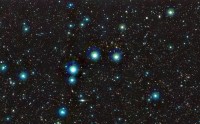
A team led by University of Edinburgh astrophysicist Professor James Dunlop has released the most sensitive ever infrared image of a representative region of the distant Universe.
The new image comes from the first year of data taken as part of the five-year UltraVISTA survey. It was made by combining more than six thousand separate exposures equivalent to an exposure time of 55 hours. The image reveals more than 200,000 galaxies, including the most massive galaxies yet seen in the early Universe, objects which formed less than one billion years after the Big Bang.
Commenting on these revolutionary new images, Prof Dunlop said: "Until recently our view back to the first epoch of galaxy formation has been limited to tiny, "pencil-beam" images made with the Hubble Space Telescope. Now VISTA, with its panoramic imaging capability, is providing us with the first view of truly representative regions of the young Universe. This image is just a first taste of what the UltraVISTA survey will ultimately provide."
"UK astronomers can be very proud of this achievement. Until the launch of the James Webb Space Telescope, UltraVISTA gives us the best view we will have of the large-scale distribution of the earliest galaxies." Prof John Peacock, Head of the University of Edinburgh's Institute for Astronomy.
The UltraVISTA survey area co-incides with the location of the largest optical image taken with the Hubble Space Telescope, termed the COSMOS survey. The combination of the existing Hubble optical imaging and the new VISTA near-infrared data provides a treasure trove for a wide range of astronomical studies. The final UltraVISTA image is expected to reveal objects 5-10 times fainter still, enabling the study of galaxy evolution over essentially all of cosmic time.
The image combines exposures taken through five different near-infrared filters using the European Southern Observatory's new VISTA telescope, located at the Paranal Observatory in Chile. The design and construction of VISTA was also led from Edinburgh, at the UK Astronomy Technology Centre at the Royal Observatory Edinburgh (ROE). The synergy of academic and technological expertise makes the ROE one of the worlds leading astronomical institutions.
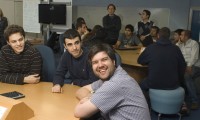
Our MSc in High Performance Computing (HPC) is a well established programme that provides an excellent grounding in HPC technologies and their practical application.
The Virtual Open Days are live sessions in chat rooms hosted by the MSc in HPC programme director, Dr David Henty. Presentations from staff are followed by a questions and answer sessions. Topics include an introduction to the MSc in HPC programme, course contents, career opportunities, financial support and other aspects of studying with us.
If you are interested in applying for the MSc in HPC, the Open Days are a good opportunity to:
• Talk to MSc staff
• Discuss career opportunities and financial support
• Meet current students
Upcoming MSc in HPC Virtual Open Days
Thursday 29th March 2012 13:00 – 14:00 BST
Wednesday 11th April 2012 12:00 – 13:00 BST
Thursday 10th May 2012 12:00 – 13:00 BST
The MSc and HECToR
The MSc is taught by experts from EPCC, a supercomputing centre based in the School. EPCC is one of the leading centres of supercomputing expertise in Europe, and it manages an extensive collection of HPC systems including the UK’s national supercomputer HECToR. HECToR has recently been upgraded to more than 90,000 processing cores, making it one of the 20 most powerful supercomputers in the world.
All our MSc students are given accounts on HECToR and they use it extensively for practical exercises and project work. The parallel programming skills taught on the MSc are also essential in exploiting the power of modern multicore processors, computing clusters and graphics processors. The MSc in HPC opens up a wide range of further research and employment opportunities in computational science, software development and HPC support. Many MSc graduates continue to study or work at the University, with 20 students having found subsequent employment at EPCC.
Registration
To book your place, email your name and the session you would like to attend to: msc [at] epcc.ed.ac.uk
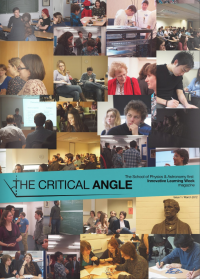
The University's first Innovative Learning Week took place in February. During the week, teaching on most courses was replaced by activities designed to explore new ways of learning and to improve our students' university experience.
With the job market increasingly competitive and additional activities important for CVs, Innovative Learning Week gave students an opportunity to participate in events that were experimental, innovative and fun but which also enhanced skills relevant to employability.
The School’s programme provided a mix-and-match menu of talks, projects and workshops from which students could freely choose. There were events suitable for those aiming for leadership roles in society, for future entrepreneurs and for those interested in science communication and teaching. Students intending to take a Physics PhD and those who hope to use subject-specific skills like coding and mathematics could also follow their interests.
As part of the ‘Communicators’ strand, a group of First Year students produced a magazine, The Critical Angle, which reports and comments on the events of the week. The students who worked on the magazine demonstrated excellent teamwork skills in producing a publication with impressively high production values that is well-balanced and informative. Please take a look and magazine [at] ph.ed.ac.uk (subject: Critical%20Angle%20) (let us know) what you think.

The MSc in High Performance Computing (HPC) teaches students the tools and techniques they require to program modern parallel computers. As part of the first University of Edinburgh Innovative Learning Week, we offered them a "Cluster Building Challenge".
The MSc focuses on using modern HPC facilities for computational science applications in both research and industry. System administration is not taught, as it is assumed that students will use computers that are maintained and supported centrally. However, as HPC is at the leading edge of computing technology, a certain level of practical experience of "under-the-hood" system administration can be quite useful in understanding how machines actually work and may be helpful in diagnosing the causes of any unexpected behaviour.
To support this, the MSc in HPC decided to develop a ‘scrapheap challenge’ exercise for students to put together small-scale parallel machines completely from scratch, using Open Source software and a range of otherwise unwanted computing and networking hardware. The Innovative Learning Week comes at an ideal time in the MSc calendar as students have already learned the basics of parallel programming in the first semester.
Sixteen students signed up for the challenge. They were split into four teams and asked to choose a team name and design a logo for their customised team T-shirts! Each team was challenged to build a demonstration scale cluster from one of several different collections of spare hardware and undertake a short investigation tailored to their particular hardware. Three different challenges were devised, depending on the hardware available:
- "The Expendables" and "The Jedi Knights" undertook the Heterogeneous Challenge. They were given a mixed bag of desktops and laptops, and asked to put them together into a single computer cluster and then run an image-processing application as fast as possible.
- "Big Data" was given a rack of low-power servers and asked to run a datamining application as efficiently as possible.
- "-O3" took a stack of old computer servers and tried to get the highest performance possible using the standard HPC Linpack performance benchmark.
An open “show and tell” session was held on the last day of the challenge. Each team demonstrated its cluster and talked about the successes and failures of their challenge to many interested staff and undergraduate students.
"I was very impressed that all the teams produced working parallel clusters from a heap of old hardware, very basic instructions and a pile of blank DVDs!” Dr David Henty, MSc in HPC Programme Director
Overall the Cluster Challenge was a great success, with our students enjoying building and working with their systems -despite the inevitable setbacks and frustrations! We definitely plan to repeat the challenge in future years.
Current student and challenge team member Ioan Hadade said:
“The Cluster Building Challenge has been an excellent opportunity to put into practice the knowledge gathered through our MSc in High Performance Computing course. It was very interesting to witness first hand the importance of finding the right synergy between the hardware and software components in order to squeeze every possible ounce of performance from any computing system.
"Our task was to build, configure and fine tune a computer cluster using spare computing machines and benchmark their performance on a suite of applications including High Performance Linpack, a benchmarking tool that is used to classify the world's most powerful supercomputers. After an entire week of hard work, our efforts have been rewarded by obtaining 40 MFlops per Watt performance which positioned our system within the Top 500 Green list!
"I am very grateful to EPCC and Dr David Henty for all the effort that was put into making this exercise possible. I would truly encourage that this exercise be continued in the following years and perhaps even culminating with a presence at the ISC's Cluster Building Challenge.”
The MSc in HPC would like to thank Kym Eden-Jones and Gareth Francis for their help in putting the challenge together and the Principal's Teaching Awards Scheme and the School of Physics ILW fund for financial support.
Image gallery
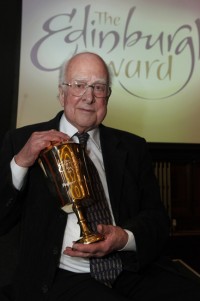
Theoretical physicist Professor Peter Higgs has been presented with the 2011 Edinburgh Award. Previous winners of the prize, organised by the City of Edinburgh Council and nominated by the citizens of Edinburgh for their outstanding contribution to the city, include Sir Chris Hoy and JK Rowling.
A sculpture of Professor Higgs’ handprints, engraved in Caithness stone, has been installed on a flagstone in the City Chambers quadrangle alongside those of the previous Edinburgh Award recipients. Professor Higgs will also receive an engraved Loving Cup - a traditional two-handled drinking vessel that represents friendship.
"It is a great honour to receive this award from the city that I fell in love with and is now my adopted home." Professor Peter Higgs
Speaking at the Award, Professor Richard Kenway said: "Discovery of the Higgs boson would be the culmination of 20th century theoretical physics; its absence would mark the most massive deception ever perpetrated by Nature!"
In 1964, Professor Higgs developed his theory of the Higgs boson, an important ingredient in the Standard Model of particle physics, which helps explain how objects have mass. Professor Higgs’s theory has formed part of the research being carried out at the European Organisation for Nuclear Research (CERN) in Switzerland. In 2011, scientists at CERN announced they had glimpsed the Higgs boson and hope to confirm whether it does or does not exist in 2012. Should Professor Higgs' theory be proven, it is widely predicted that he would be awarded the Nobel Prize for Physics.
Image gallery
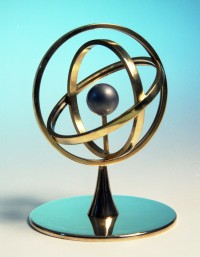
Even at the absolute zero of temperature, theory predicts that atoms still have kinetic energy causing them to jiggle about. On a universal scale this so-called "Zero Point Energy" far outweighs all other sources of energy, but extracting it is exceptionally difficult.
Researchers in the School's Institute for Condensed Matter and Complex Systems (ICMCS) have made a number of remarkable discoveries in high pressure lithium over the last few years, and a paper published this week in top Physics journal Physical Review Letters (108, 055501, 2012) explains the previously mysterious stability of the so-called oC88 high pressure phase.
Under 60GPa of pressure - comparable to that found deep in the Earth's mantle - lithium changes its crystal structure to a form called oC88. Previous calculations showed that oC88 requires more energy to form than could be supplied by squeezing, but Eugene Gregoryanz' group showed that the atoms in oC88 move at a much lower frequency than other allotropes of lithium (see figure). Careful calculation by a team led by Graeme Ackland showed that this means that oC88 contained very low zero-point energy, and so it is formed by extracting the zero-point energy from the low pressure lithium.
The ability of lithium to tap zero-point energy is unrelated to the antimatter storage properties of dilithium in Star Trek. This is because the former is true and the latter is made up.
Image gallery

Panton Fellowships offer £8,000 to scientists who promote open data in science. Apply now!
Panton Fellowships can be held whilst you are working or studying, and should supplement your current funding. Fellowships last for one year. The scheme is designed to be flexible, and there is scope for Fellows to carry out a range of activities.
Fellows may wish to:
* Initiate discussion about the role and value of openness,
* Explore practical solutions for making data open
* Catalyse the scientific community and for push change.
Panton Fellowships are open to all, and are particularly suited to graduate students and early-stage career stage scientists. The scheme is overseen by a distinguished Advisory Board of scientists and open data advocates. To be eligible, applicants must have the relevant rights to work in the UK, and should reasonably expect to be working and/or studying in the UK until March 2013.
Applicants should send a CV and covering letter to jobs [at] okfn.org by 24th February.
See the Panton Principles website for full details.
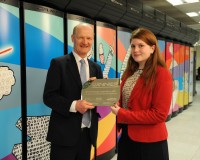
Imagine if every person on the planet were able to carry out 250,000 calculations per second simultaneously. This is the combined capability of the next stage of development of two giant computers, HECToR and BlueGene/Q, based at the University of Edinburgh’s Advanced Computing Facility (ACF).
The computers can deliver complex computer simulations across a range of scientific disciplines and are funded by four of the UK Research Councils, EPSRC, STFC, NERC and BBSRC. Their increased computing capacity and performance will help UK researchers’ work in forecasting the impact of climate change, the fundamental structure of matter, fluctuations in ocean currents, projecting the spread of epidemics, designing new materials, the structure and evolution of the universe and developing new medicinal drugs.
Launching the new phases at an event jointly hosted by the University of Edinburgh and the UK Research Councils, Minister for Universities and Science, David Willetts, said: “E-infrastructure is fundamental to modern research and development. It helps our world-leading science base achieve breakthroughs across a range of important disciplines and helps industry design and manufacture new products.
“These impressive new supercomputers will drive growth and innovation. They will provide UK businesses and researchers with the technology they need to compete successfully on a global scale.”
Mr Willetts also presented a plaque to the winner of a schools art competition to produce a design for the front panels of the HECToR computer.
"We are delighted to host the next generation in supercomputing capability for researchers across the UK. HECToR and BlueGene/Q will each play a significant role in facilitating ground-breaking research across many areas of science, with tremendous benefits for society. We look forward to working with our partner organisations in delivering this computing capability and to seeing the contribution it will make." Professor Sir Timothy O'Shea, Principal, University of Edinburgh
Commenting on HECToR Phase 3, which has been funded by a £13.9 million grant from the Engineering and Physical Sciences Research Council (EPSRC), which manages the service, Professor David Delpy, Chief Executive, said: “High Performance Computing is vital to supporting the development of science, discovery and new commercial partnerships. As HPC becomes more powerful, and it is possible to model more complex problems in greater detail, the types of simulation that HECToR is capable of become an increasingly valuable tool.”
Professor John Womersley, Chief Executive Officer of STFC said: “Supercomputers are the essential, behind-the-scenes tools that enable modern science. Whether you are analysing climate data from a satellite, designing a new medicine or looking for the Higgs boson, access to high performance computers is vital. These new computers will undoubtedly facilitate breakthroughs across the scientific disciplines, and lead to additional economic and societal benefits for the UK.”
Also announced at the launch was the winner of a schools art competition to design a pictorial representation of the work carried out by HECToR. The winning picture has been placed on the front panels of the computer.
The winner, sixteen-year-old Lily Johnson, from Hethersett Old Hall School, Nr Norwich, said: “I entered the HECToR design competition at the suggestion of my chemistry teacher, Miss Mann. After reading about the capabilities of the supercomputer I wanted to represent these in my design.
“The rain, cloud and sun represent mapping weather patterns and climate change, the volcano the prediction of natural disasters, the syringe and tablets the computer’s application in medical advances, the leaf the advancing of understanding complex biological systems and the aeroplane the computer’s role in improving engineering of aircraft.
“I put these around a globe as the work of the computer has global benefits. All the pictures are coloured in binary code to show how the technology links them all together.
“I am very honoured that my design has been chosen for the computer, as its work will be influential in so many fields. It is an amazing next technological step in the important issues affecting our lives, such as climate change.”
Both the BlueGene/Q and HECToR facilities have approximately the same computational performance, 800 Teraflops (800 million million million million). HECToR has a memory of 90 Terabytes – equivalent to that of over 180,000 iPhones. It also has one Petabyte of disk space for storing data. If your iPhone had that much space it could hold 200 million tracks, and if you started listening to each one of them in 2012, you would still be listening in 3153.
The BlueGene/Q design achieves a very high concentration of computing power in a small space and is the most energy efficient supercomputer ever built. Using just the electricity it takes to power a light bulb it can perform the calculations of 100 laptops.
Image gallery
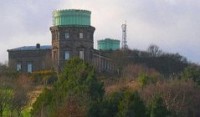
Congratulations to the ROE astronomers who were honoured in the recent set of awards given out by the Royal Astronomical Society (RAS).
Dr Tom Kitching, a Fellow at the Institute for Astronomy, was given the award for postdoctoral researcher whose career has shown most promise. The United Kingdom Infrared Telescope Infrared Deep Sky Survey (UKIDSS) - which includes the School's Prof. Andy Lawrence and Dr Nigel Hambly - was given the RAS Group Award. The citations are below.
Winton Capital Award for Astronomy: Dr Tom Kitching
Dr Tom Kitching has been given the 2012 Winton Capital Award, which recognises a postdoctoral researcher who completed their PhD no more than 5 years previously and whose career has shown the most promising development.
Dr Kitching, who now holds a RAS postdoctoral fellowship, contributes at all levels to research into weak gravitational lensing, from the details of shape measurement of galaxies, through development of sophisticated analysis tools, to leadership roles in ESA's forthcoming Euclid space mission that will map dark matter and investigate dark energy.
As a student, he helped develop the new field of 3D weak lensing and, with its inventor Prof. Lance Miller, is the co-creator of an algorithm that measures the distortion of galaxy images. As a result of his particular expertise he was invited to join the leading ground-based lensing survey (CFHTLenS) and the leading space-based survey (COSMOS, using the Hubble Space Telescope).
RAS Group Award: UKIDSS
The United Kingdom Infrared Telescope Infrared Deep Sky Survey (UKIDSS) project has been awarded the RAS Group Award. The consortium behind the project began their work in 2005 and since that time has published more than 200 refereed papers. Significant science results from UKIDSS include the discovery of a quasar at a redshift of 7 (meaning that the light we detect from it left more than 13 billion years ago) and finding many examples of the new cool T-dwarf objects. Some of the latter are amongst the coolest astronomical objects known.
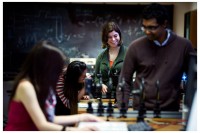
Two innovative professional development courses for educators involved in the design and delivery of science teaching at secondary level or early-years HE will be offered by the School from September 2012 as part of the University of Edinburgh’s Distance Education Initiative.
These Research-Informed Science Education (RISE) courses - ‘Research Based Instructional Strategies in the Science Classroom’ and ‘Technology Enhanced Learning in the Science Classroom’ - are Masters level courses that can form the basis of a Postgraduate Certificate in Science Education Research. The courses are endorsed by the Institute of Physics and the Royal Society of Chemistry.
The RISE courses are strongly aligned to the research activities of the Edinburgh Physics Education Research group (EdPER) and will appeal to teachers who have been away from formal study for some time and wish to undertake accredited CPD (continuing professional development) without taking extended leave from the classroom.
Further information
To find out more contact Crystal Lei, RISE course secretary:rise-info [at] ed.ac.uk

